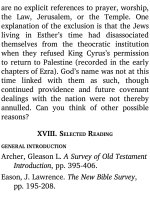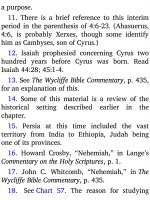Jensens survey of the old testament adam 530
Bạn đang xem bản rút gọn của tài liệu. Xem và tải ngay bản đầy đủ của tài liệu tại đây (153.28 KB, 4 trang )
A.D.
50.
5. If Galatians was not the rst to be
written, as many hold, then the
Thessalonian letters were Paul’s
rst
inspired writings.
6. The mid-tribulation view sees the rapture
in the middle of the Tribulation period; the
posttribulation view sees it at the end of the
Tribulation.
7. Before Calvary, the spirits of deceased
believers went to the blessed of the two
regions of Sheol, that part reserved only for
God’s people. After Calvary, only Sheol’s
other region, the place of torment (new
name “Hades”), remained, since thereafter
the spirits of believers at death would go to
paradise. (Cf. Luke 23:43.)
8.
Outside
sources
include
Bible
dictionaries, encyclopedias, handbooks, and
books with the subject titles.
9. F. F. Bruce, “1 Thessalonians,” in The
New Bible Commentary, p. 1159.
10. R. H. Walker, “The Second Epistle of
Paul to the Thessalonians,” in The
International Standard Bible Encyclopedia,
5:2968.
11. Adapted from J. Dwight Pentecost,
Things to Come, pp. 206-7.
12. “by … report or letter supposed to have
come from us, saying that the day of the
Lord has already come” (2:2, NIV).
13. Summary paraphrase of 2:1-12.
14. C. F. Hogg and W. E. Vine, The Epistles
to the Thessalonians, p. 245.
18The Pastoral Epistles and Philemon
1 Timothy: Godliness and Pastoral Care
Titus: Adorning the Doctrine of God
2 Timothy: Endurance and Separation in the
Ministry
Philemon: Appeal for Forgiveness
Paul wrote about half the New
Testament’s twenty-seven books. The last
three that he wrote were 1 Timothy, Titus,
and 2 Timothy, in that order. The letters
have since been called pastorals, for reasons
to be given below. The very fact that these
letters were written toward the end of such
an outstanding career is a promise of much
spiritual insight and inspiration to all who
would study the letters.
About a year before writing 1 Timothy,
Paul wrote a short letter to Philemon. This
letter appears last in the canonical list of
Paul’s writings, hence it is the last to be
studied in this survey series.
The pastoral epistles and Philemon are
messages from one heart to another. Here
we can learn much about individual
Christians: Paul and Timothy and Titus;
Philemon and Onesimus; and the members
of churches in Ephesus and Crete and
Colossae. And because human nature does
not change from generation to generation,
we can easily see why these letters are so
contemporary in their message to us.
I. PREPARATION FOR STUDY
It will help you to prepare for your study
of each of the pastoral epistles by rst
viewing them as a group.









